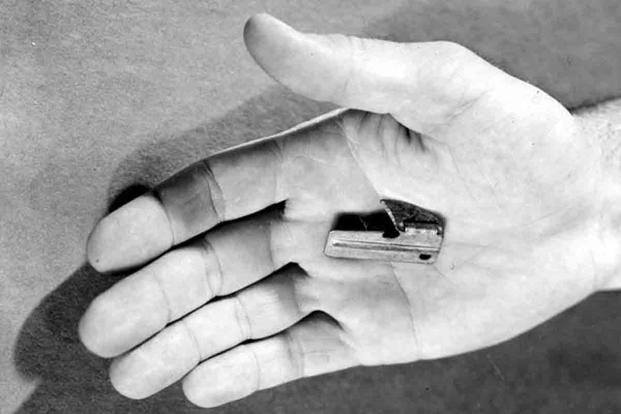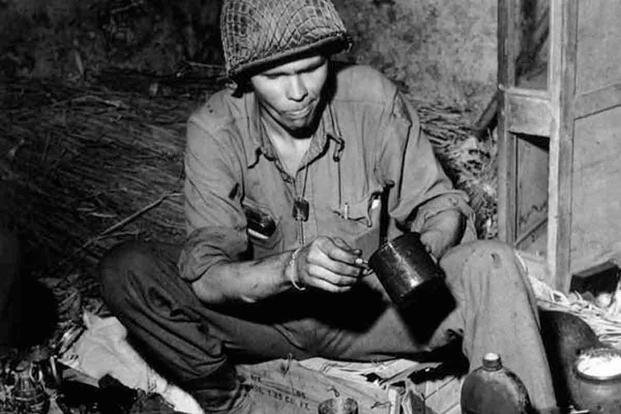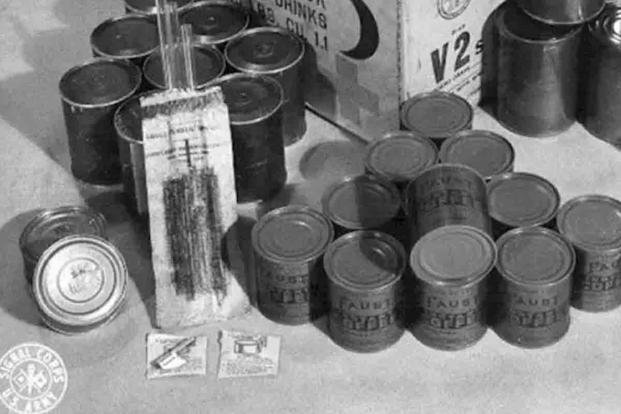Odds are that when someone mentions John Wayne, they're either thinking about western movies or some old war film. The actor John Wayne never served in the U.S. military, but the classic "John Wayne" served through World War II, the Korean War and in Vietnam, right up until the early 1980s.
The title of "John Wayne" was just a nickname for the P-38 "Opener, Can, Hand, Folding, Type I." It was also a little piece of gear that veterans of these time periods just could not do without. The actor mattered little, but the simple can opener was so important that many veterans still carry it with them today.
Read: Why John Wayne Was Labeled a 'Draft Dodger' During World War II
The P-38 is a short, metal blade with a short, metal handle. The blade is in the shape of a tooth and swings out from the handle from a hinge, allowing the user to pierce a tin lid. It folds back up when not in use, to keep from injuring the user.

A standard-issue P-38 was an object close to the hearts of many who served between 1942 and 1980, often literally, as it could be carried on the same chain as dog tags. It was one piece of equipment issued by the military that was a prime example of the "keep it simple, stupid" school of engineering. Cheap, indestructible and lightweight, it did what it was supposed to do in just 38 punches.
The Army began issuing C-rations just before the United States entered World War II. These rations came in cans for easy transport and reduced spoilage. They lasted so long that some of the C-rations made for use in World War II found their way to the Korean Peninsula in 1950.
With food being stored in cans, and since the easy-open, pull-back can wouldn't be introduced until 1960, the military needed a way for each individual troop to open their rations. Carrying a hand-cranked can opener in standard infantry packs just wouldn't do, so the U.S. Army's Quartermaster Subsistence Research and Development Laboratory in Chicago got to work.
A team of some of the best industrial designers in the United States developed this sturdy, durable and rustproof device that made canned rations a workable concept in just 30 days. It's smaller than a hand-crank opener, lighter and cheaper to manufacture, perfect for troops in the field.

That perfection may be because of the officer in charge of the lab at the time, Col. Roland Isker. Isker was a longtime veteran by 1942, having served on the Mexican border under Gen. John J. Pershing, training officers for World War I and having served overseas in the Philippines, Siberia and China.
So how did it acquire the nickname "John Wayne?" There are a couple of theories.
Actor John Wayne was known for characters that were tough and could take a beating as well as they could give one, much like the P-38. In an episode of the History Channel's "Mail Call," Gunny R. Lee Ermey says that Marines in Vietnam called it the "John Wayne" for this reason.
At the time, almost everything issued came with a short film, showing troops how to use the equipment. For the can opener's U.S. Navy training film, Wayne provided the voiceover and was shown using one to open a can.
After 40 years and more than a billion P-38s produced and stamped with the standard "US," the can opener finally went out of production in the early 1980s. Canned rations were being replaced with the new Meals, Ready-to-Eat packaging, a bag that didn't require the use of a can opener.
There are troops who would argue that their trusty P-38 still has its field uses, however. It was used as a seam ripper, a screwdriver, prying tool, wire stripper, letter opener and box cutter, just to name a few.
-- Blake Stilwell can be reached at blake.stilwell@military.com. He can also be found on Twitter @blakestilwell or on Facebook.
Want to Learn More About Military Life?
Whether you're thinking of joining the military, looking for post-military careers or keeping up with military life and benefits, Military.com has you covered. Subscribe to Military.com to have military news, updates and resources delivered directly to your inbox.
















